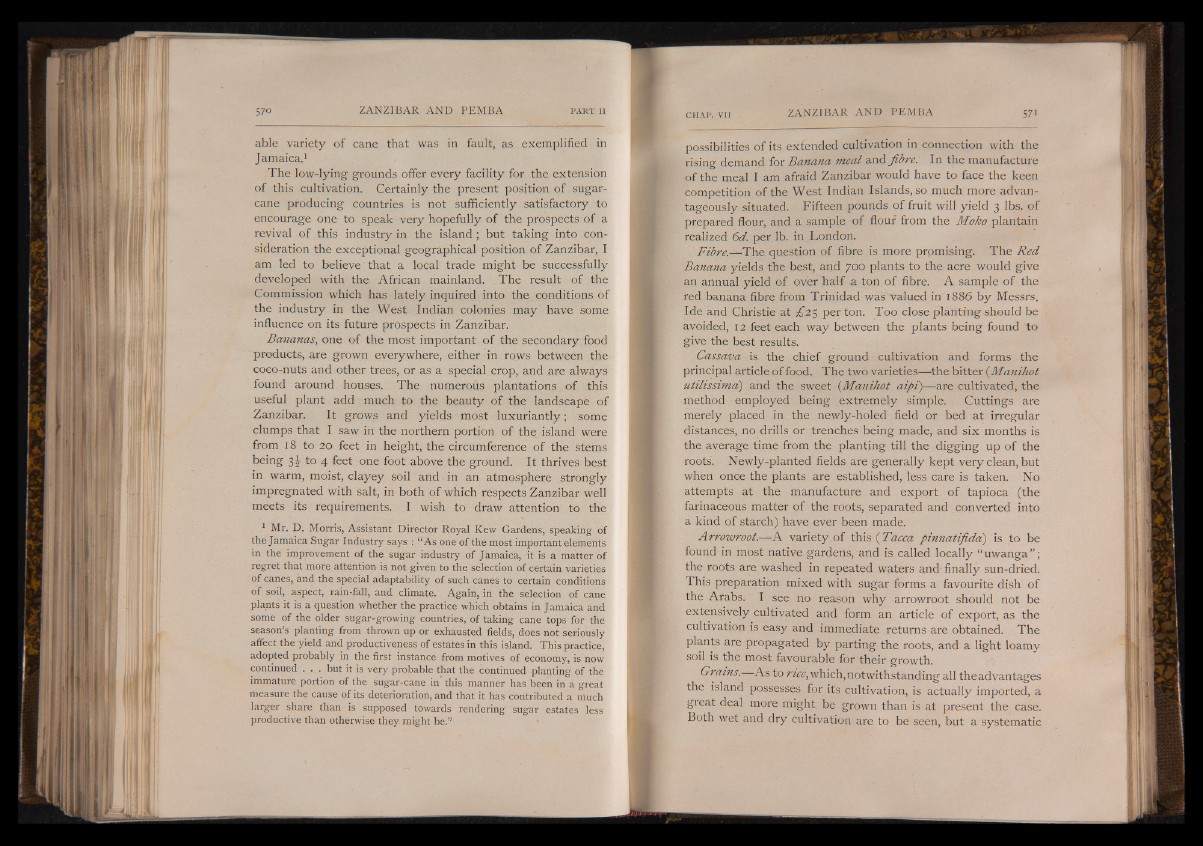
able variety of cane that was in fault, as exemplified in
Jamaica.1
The low-lying grounds offer every facility for the extension
of this cultivation. Certainly the present position of sugarcane
producing countries is not sufficiently satisfactory to
encourage one to speak very hopefully of the prospects of a
revival of this industry in the island; but taking into consideration
the exceptional geographical position of Zanzibar, I
am led to believe that a local trade might be successfully
developed with the African mainland. The result of the
Commission which has lately inquired into the conditions of
the industry in the West Indian colonies may have some
influence on its future prospects in Zanzibar.
Bananas, one of the most important of the secondary food
products, are grown everywhere, either in rows between the
coco-nuts and other trees, or as a special crop, and are always
found around houses. The numerous plantations of this
useful plant add much to the beauty of the landscape of
Zanzibar. It grows and yields most luxuriantly; some
clumps that I saw in the northern portion of the island were
from 18 to 20 feet in height, the circumference of the stems
being 3J to 4 feet one foot above the ground. It thrives best
in warm, moist, clayey soil and in an atmosphere strongly
impregnated with salt, in both of which respects Zanzibar well
meets its requirements. I wish to draw attention to the
1 Mr. D. Morris, Assistant Director Royal Kew Gardens, speaking of
the Jamaica Sugar Industry says : “ As one of the most important elements
in the improvement of the sugar industry of Jamaica, it is a matter of
regret that more attention is not given to the selection of certain varieties
of canes, and the special adaptability of such canes to certain conditions
of soil, aspect, rain-fall, and climate. Again, in the selection of cane
plants it is a question whether the practice which obtains in Jamaica and.
some of the older sugar-growing countries, of taking cane tops for the
season’s planting from thrown up or exhausted fields, does not seriously
affect the yield and productiveness of estates in this island. This practice,
adopted probably in the first instance from motives of economy, is now
continued . . . but it is very probable that the continued planting of the
immature portion of the sugar-cane in' this manner has been in a great
measure the cause of its deterioration, and that it has contributed a much
larger share than is supposed towards rendering sugar estates less
productive than otherwise they might be.”
possibilities of its extended cultivation in connection with the
rising demand for Banana meal and fibre: In the manufacture
of the meal I am afraid Zanzibar would have to face the keen
competition of the West Indian Islands, so much more advantageously
situated. Fifteen pounds of fruit will yield 3 lbs. of
prepared flour, and a sample of flour from the Moko plantain
realized 6d. per lb. in London.
Fibre.— The question of fibre is more promising. The Red
Banana yields the best, and 700 plants to the acre would give
an annual yield of over half a ton of fibre. A sample of the
red banana fibre from Trinidad was valued inT886 by Messrs.
Ide and Christie at £2$ per ton. Too close planting should be
avoided, 12 feet each way between the plants being found to
give the best results.
Cassava is the chief ground cultivation and forms the
principal article of food. The two varieties— the bitter (Manihot
utilissimd) and the sweet (Manihot aipi)— are cultivated, the
method employed being extremely simple. Cuttings are
merely placed in the newly-holed field or bed at irregular
distances, no drills or trenches being made, and six months is
the average time from the planting till the digging up of the
roots. Newly-planted fields are generally kept very clean, but
when once the plants are established, less care is taken. No
attempts at the manufacture and export of tapioca (the
farinaceous matter of the roots, separated and converted into
a kind of starch) have ever been made.
A rrowroot.— A variety of this ( Tacca pinnatifida) is to be
found in most native gardens, and is called locally “uwanga” ;
the roots are washed in repeated waters and finally sun-dried.
This preparation mixed with sugar forms a favourite dish of
the Arabs. I see no reason why arrowroot should not be
extensively cultivated and form an article of export, as the
cultivation is easy and immediate returns are obtained. The
plants are propagated by parting the roots, and a light loamy
soil is the most favourable for their growth.
Grains.— As to rice, which, notwithstanding all the advantages
the island possesses for its cultivation, is actually imported, a
great deal more might be grown than is at present the case.
Both wet and dry cultivation are to be seen, but a systematic